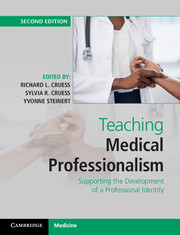Book contents
- Frontmatter
- Contents
- List of contributors
- Foreword
- Introduction
- Part I What is to be taught and learned
- Part II Theory
- Part III Principles
- 8 General principles for establishing programs to support professionalism and professional identity formation at the undergraduate and postgraduate levels
- 9 Faculty development to support professionalism and professional identity formation
- 10 Becoming interprofessional: professional identity formation in the health professions
- 11 Assessment of professionalism and progress in the development of a professional identity
- 12 Remediation of unprofessional behavior
- 13 Professional identity formation, the practicing physician, and continuing professional development
- 14 Professionalism, professional identity, and licensing and accrediting bodies
- Part IV Case studies in promoting professionalism and professional identity formation across the continuum
- Part V The future
- Index
- References
10 - Becoming interprofessional: professional identity formation in the health professions
from Part III - Principles
Published online by Cambridge University Press: 05 April 2016
- Frontmatter
- Contents
- List of contributors
- Foreword
- Introduction
- Part I What is to be taught and learned
- Part II Theory
- Part III Principles
- 8 General principles for establishing programs to support professionalism and professional identity formation at the undergraduate and postgraduate levels
- 9 Faculty development to support professionalism and professional identity formation
- 10 Becoming interprofessional: professional identity formation in the health professions
- 11 Assessment of professionalism and progress in the development of a professional identity
- 12 Remediation of unprofessional behavior
- 13 Professional identity formation, the practicing physician, and continuing professional development
- 14 Professionalism, professional identity, and licensing and accrediting bodies
- Part IV Case studies in promoting professionalism and professional identity formation across the continuum
- Part V The future
- Index
- References
Summary
Introduction
Professional programs in higher education, such as healthcare, aim to prepare students for practice through the acquisition of appropriate and relevant knowledge, skills, attitudes, and values. They should also focus on students’ integration into the profession: their becoming professionals and subsequently being professionals.1 However, as professional identity formation has been conceptualized as “an on-going process of interpretation and re-interpretation of experiences,”2 one could argue that an individual can never be but is always becoming a professional. There is, however, a frequently held assumption of one profession, one identity, although a professional is acknowledged as having multiple roles. In this chapter, we question what happens to professional identity in the context of modern healthcare and contemporary education of the health professions, which is increasingly characterized by teamwork and collaborative practice, and accordingly, whether healthcare professionals also need to nurture and sustain an interprofessional identity. The question then follows as to whether their interprofessional identity subsumes the uniprofessional or whether an individual may move between the two identities depending on context and inclination. Are health professionals plural actors as the French sociologist Lahire suggests? “And so we are plural, different in the different situations of ordinary life, foreign to other parts of ourselves when we are engaged in this or that domain of social existence.”3 Daily living involves circulation through different roles: employee, researcher, parent, partner, teacher, and practitioner. But in these roles, are people mainly demonstrating differences in behavior depending on context rather than identity? Are healthcare professionals and students doing rather than being or becoming? As Hafferty has suggested in relation to medical students, the act of developing a “professional presence” is “best grounded in what one is rather than what one does.”
“Being interprofessional” has been described as consisting of three aspects: knowing what to do (thinking about what action is needed and why); having the skills to do what needs to be done (being competent and practicing correctly); and conducting oneself in the right way during performance (including appropriate attitudes and values).5 However, these three aspects can just as easily be applied to “being professional” or being “uniprofessional.” By debating and defining interprofessional competencies and their translation into behavior in the workplace, health professional educators may gain a greater sense of the additional attributes that constitute being interprofessional.
- Type
- Chapter
- Information
- Teaching Medical ProfessionalismSupporting the Development of a Professional Identity, pp. 140 - 154Publisher: Cambridge University PressPrint publication year: 2016
References
- 16
- Cited by



